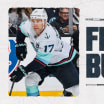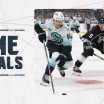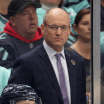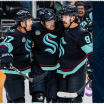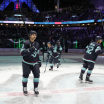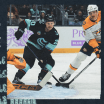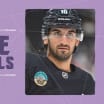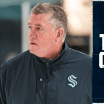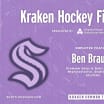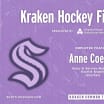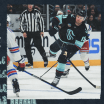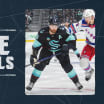In many hockey circles, the NHL Entry Draft is affectionately referred to as the "scouts' Super Bowl." It's the culmination of a tremendous amount of work over a tremendous amount of time invested in evaluating teenage hockey players and their ability to become the next pieces of a winning NHL hockey team.
But often our understanding of the evaluation process remains at the surface level. What goes into identifying and assessing the next wave of elite hockey talent? To answer that question, it is appropriate to turn to the Kraken's director of amateur scouting, Robert Kron, about the work that he and his staff does.
Let's dig in.
Scouting the Scouting Process
Our Alison Lukan "digs in" with Robert Kron, Seattle director of amateur scouting, on how Kraken discover high-potential prospects to select over seven rounds Thursday and Friday
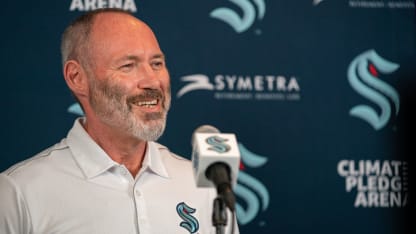
Understand a Player's Skills
If you want to know how a player plays, the most important ingredient of understanding skill level is seeing him or her do it. That's why the Kraken's
team of scouts
is constantly on the move watching hockey across North America and Europe. The goal is to see players as many times as necessary to develop a complete understanding of who the player is, plus confirm the athlete can be that player consistently.
"I don't think there's a particular number you can put on how many viewings you want to have," Kron said. "But it could be from five to 15 depending on the player. And then, with all that, with the technology available to us, we've got video we can substitute if you need more viewings or want to dig deeper."
While video can be helpful, being in the rinks is essential, no matter how
taxing the process of getting there is
. As Kron points out, video from non-NHL rinks can be of lower quality with most of that game film following the movement of the puck. That's simply not enough information for how Kron and colleagues assess their work. For instance, Kron is not just watching the shot that leads to a goal. The former NHL forward watches how a play develops, what's happening behind the play, even how individuals are conducting themselves on the bench. It's all part of knowing not just the player, but the person too.
Scouts take in a massive amount of information on a rink full of players, all doing different things at the same time, shift after shift. Who do you look at? Kron and his team do get a list of draft-eligible players each year from Central Scouting, but that's not where the scouting team starts or ends their evaluations.
For Kron's team, especially at the start of a season, the whole group scours every game for possible players to watch. Darren Yopyk, who covers western Canada and USA along with fellow Kraken scout Jeff Crisp, said he spends the first half of each hockey year identifying players he, Crisp and "cross-checker" scouts (who cover other regions for the Kraken) watch during the second half of the regular seasons and playoffs.
Kron says every scout has his or her own personal way of watching a game, but for him, he'll watch one team in period one, the other team in period two, and then focus on those individuals who stood out in the final 20 minutes of play. Reports are filed on players review by review.
"You're not looking at one particular guy, that comes later," Kron said. "You come in with fresh sets of eyes and [the players] 'come to you.' There's certain situations on the ice that happen. You see certain player types developing. You make notes. Then you go back to your notes the next time you see the player."
Repeat viewings confirm or question each "note" or opinion, and as the makeup of each player's game becomes more clear, a scout's own "list" of talent starts to take shape. As the scouting season wears on, the list of players one may focus on narrows.
But that doesn't mean other players totally fall out of frame. The story of a player isn't written in one game, or sometimes even a few. Kron has seen players rebound from bad starts or fall off after strong ones. Understanding the "why" and not just the "what" is critical.
"[Players] show you more and more [throughout a season]," Kron said. "You don't want anybody to come out of nowhere. Ideally, you want to have a book on a player before you make a decision one way or the other. You have to examine the guy who starts well and ends bad and vice versa - you try to find out why that happened."
Be Comprehensive and Collaborative
That's why a scout's evaluation doesn't end with what his or her eyes see on the ice. A visit to a rink includes talks with as many people as possible: agents, coaches, trainers - "they see the players every day on and off the ice," Kron said. All that information helps round out who a player is in sum, along with on-ice skill set.
The Kraken scouting team also looks to other specialists and experts to fully inform who a player can be. At the annual NHL Scouting Combine, a psychologist joins general manager Ron Francis and the team of scouts who interview players. With a cutting-edge analytics staff inside hockey operations, Seattle leverages data-driven analysis as they evaluate amateur talent.
"There's a lot of aspects to the process," Kron said. "The psychologist doesn't know what someone is as a player, but can give a bit of a glimpse into the personality of these kids. [Is the player] described as a natural leader? Is he more of a follower? . . .Is there a correlation to the way they play? Sometimes there is, and sometimes there is not. It's interesting.
"Obviously, analytics plays a role too. [We want to use] anything we can find to give us an edge to find the right player."
Encourage Healthy Debate
As scouts travel and evaluate players, each individual evaluation devises a list of draft-able talent along with rankings of who best matches the needs of the organization. Throughout that process, the scouting team gets together to debate the rankings of all eligible players. You hear cliches about "pounding the table" for a player, or heated exchanges, but Kron dismisses that characterization. He says the informed conversations that occur are exactly what a healthy scouting crew needs.
"There will be discussions," Kron said. "You know why a certain scout likes a certain player and why we do not but that's where the healthy debate is …exchanging information. And maybe, one scout has a different angle than the other person.
"We don't want [our scouts] to be influenced by other opinions. We ask them to have their own and we have that. But there might be certain situations, that eyes from a different angle on (a player), especially regional scouts that know their players well. They are able to stick to their [evaluations] and defend [a player's] ability. That's what we want."
Savor Selection Time
All of the scouts' work goes into forming a list - a ranking of draft-eligible players that an organization takes into the Entry Draft itself. But even then, the work for Kron's team is never truly done.
"What's the most exciting is you really don't know who you're going to [draft]," Kron said. "We can run all kinds of scenarios, watch all these mock drafts and at the end of the day, you have no idea what other teams are thinking. You might guess one way or the other, but as it unfolds, you know, especially after the first round, the work doesn't stop.
"After the first round goes, now there's 32 players off the board. You go back into the meeting room, or the "war room," so to speak, and look at what players are left and how did it change your picture? It's exciting. Especially if somebody that you really wanted in that particular draft class ends up being a player. I think that's what the scouts wish for."
That's the ultimate gift. While it can take time, to see a player you evaluated and advocated for as a scout become a legitimate part of an NHL team is the supreme future reward. Even though that outcome is deeply personal and humbling, Kron laughed gently when I asked if people say thank you when a player "makes it" in the NHL.
"I don't think the scouts are looking for a pat on the back even though you do recognize their work," Kron said. "People in the hockey world know who advocated for a player. [As a scout] You're basically looking at five years to the future. If the guy becomes what you thought he might become, then it's very satisfying to confirm, I guess, instinct. You're happy for the player. It's really feeling we saw something in the player that came to fruition down the line. It's a great feeling."


